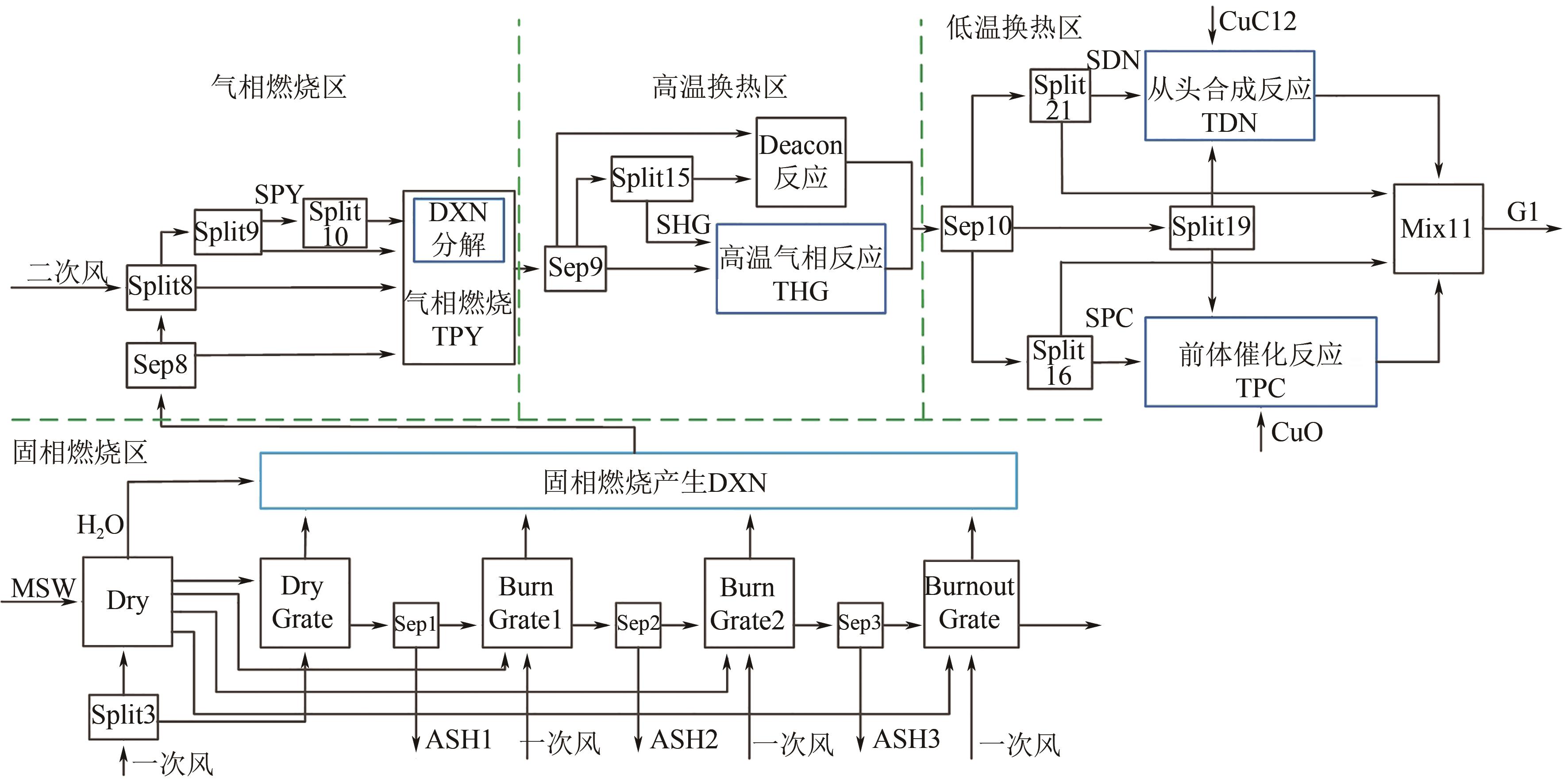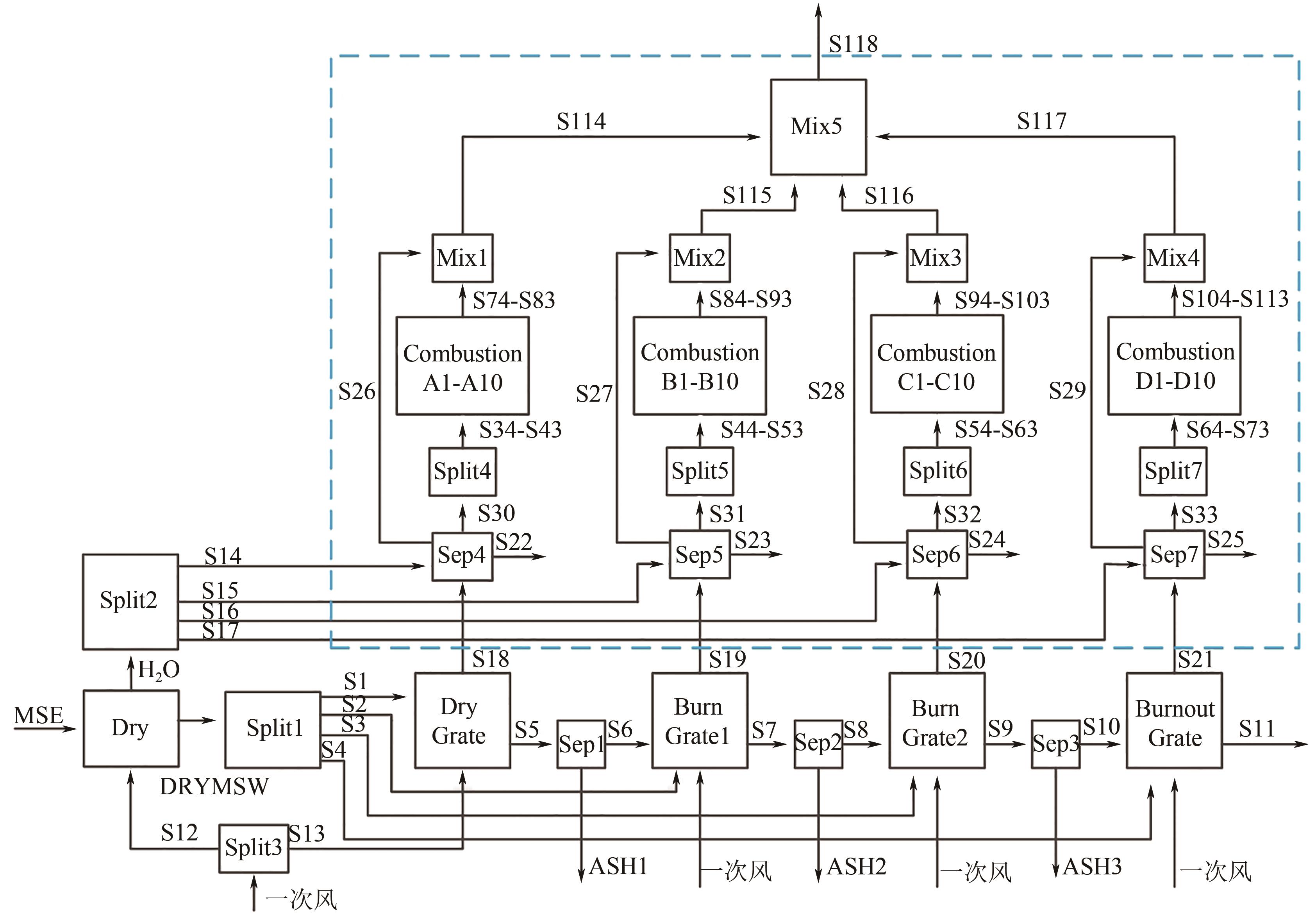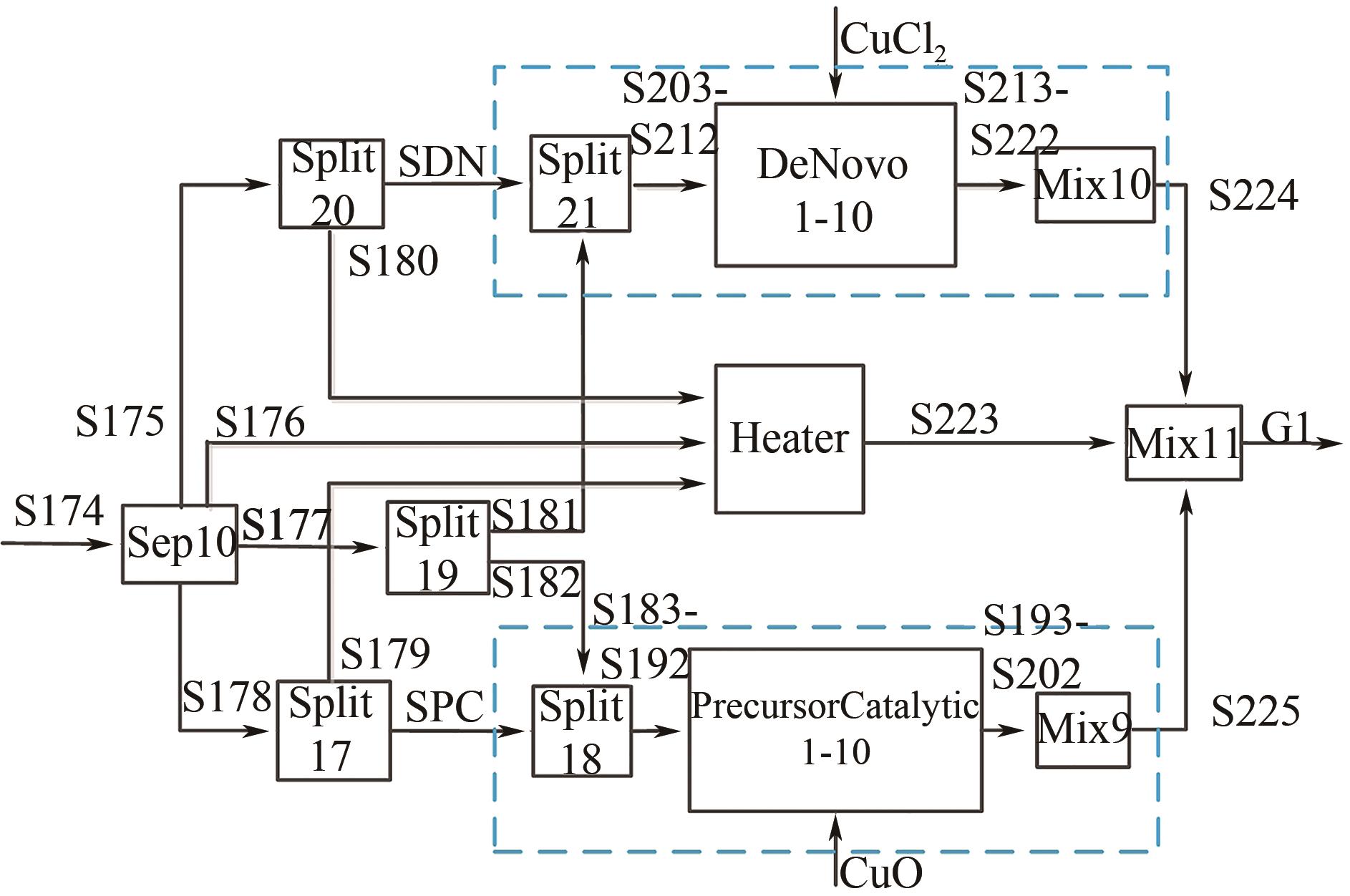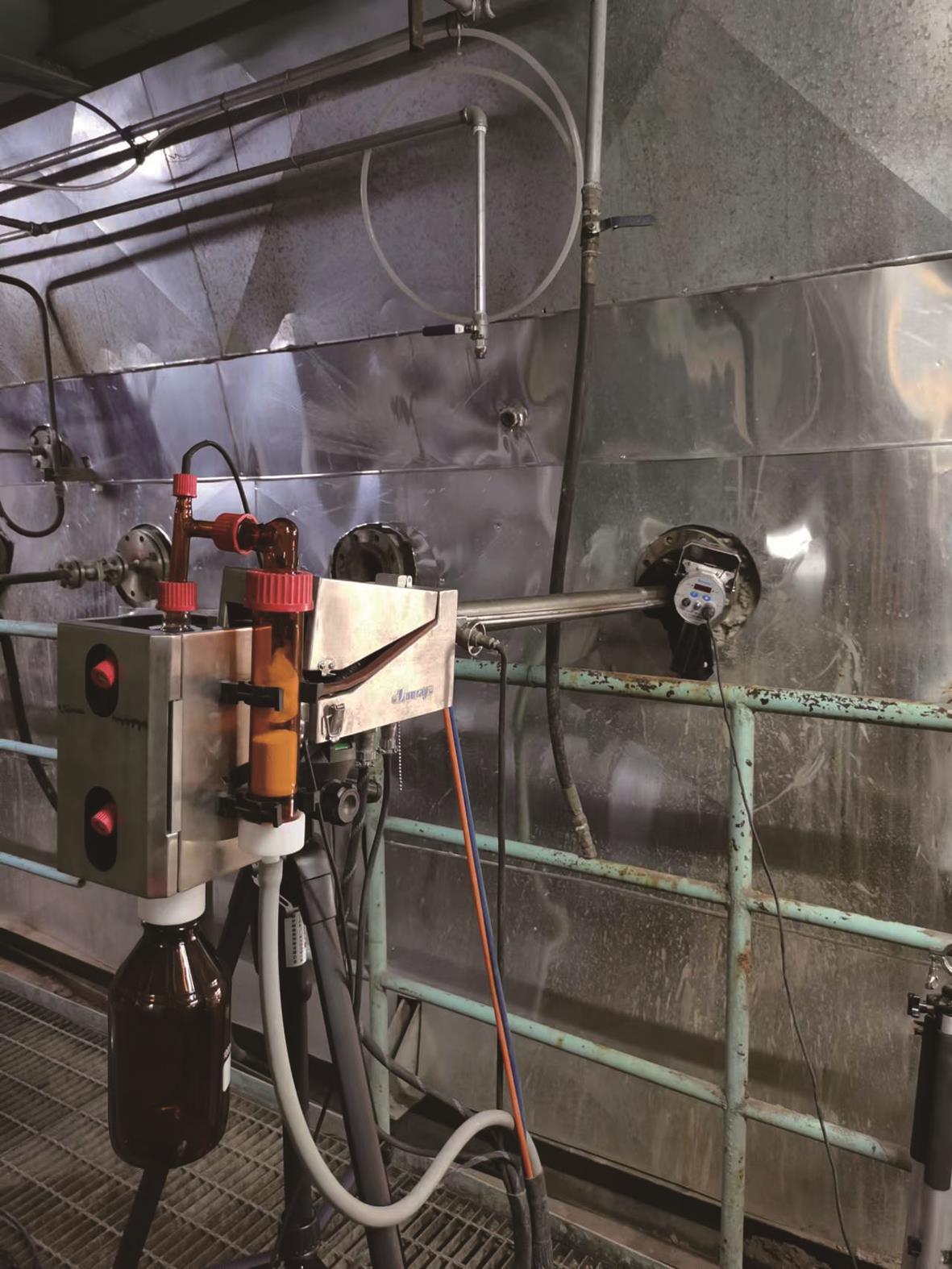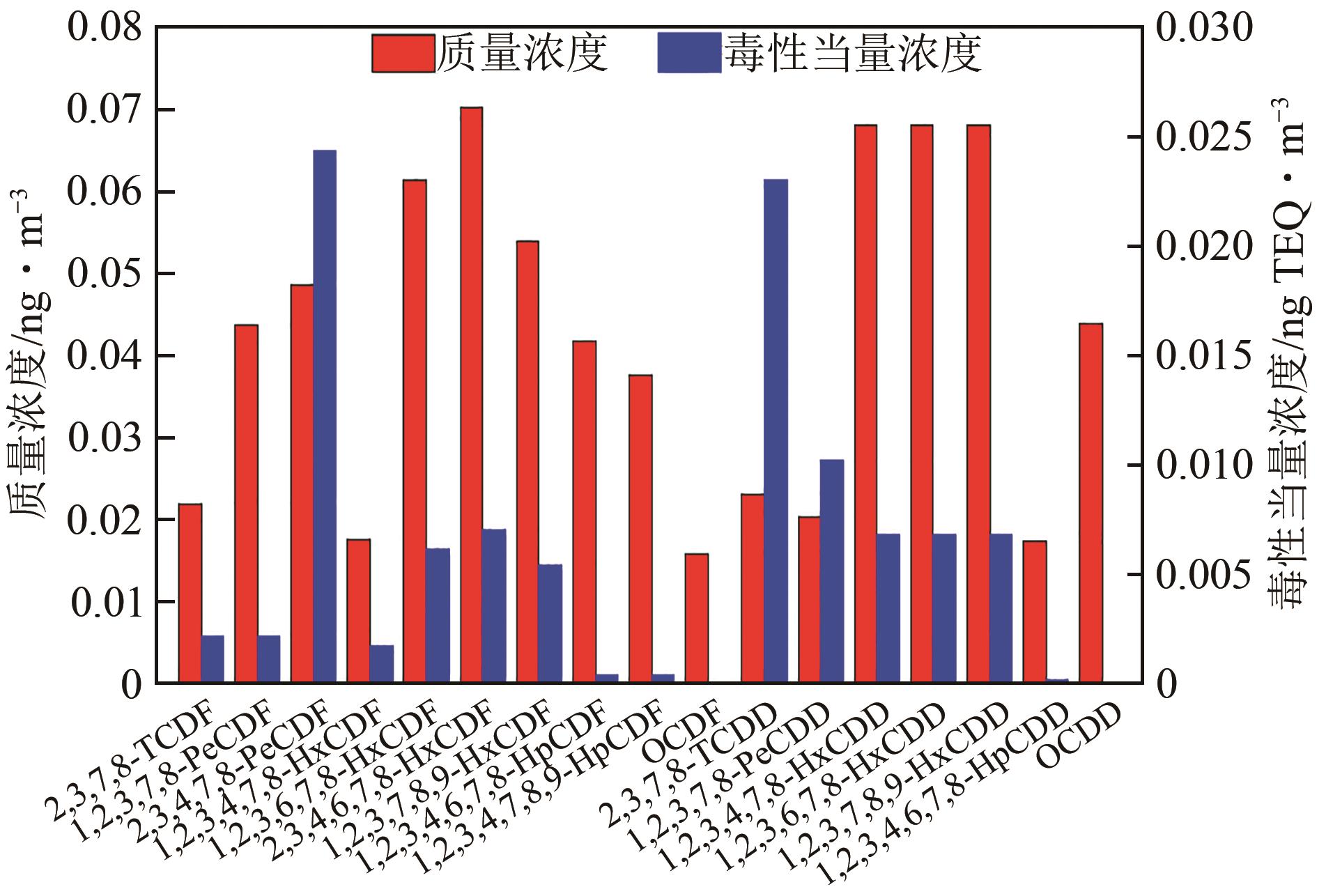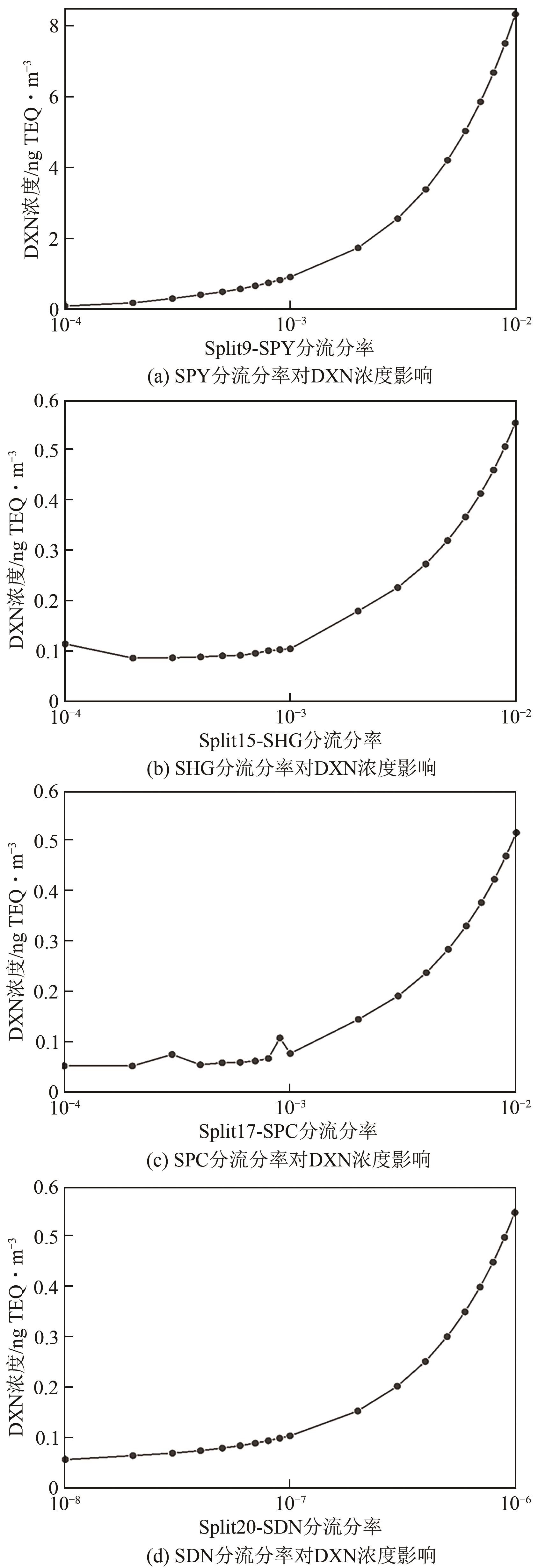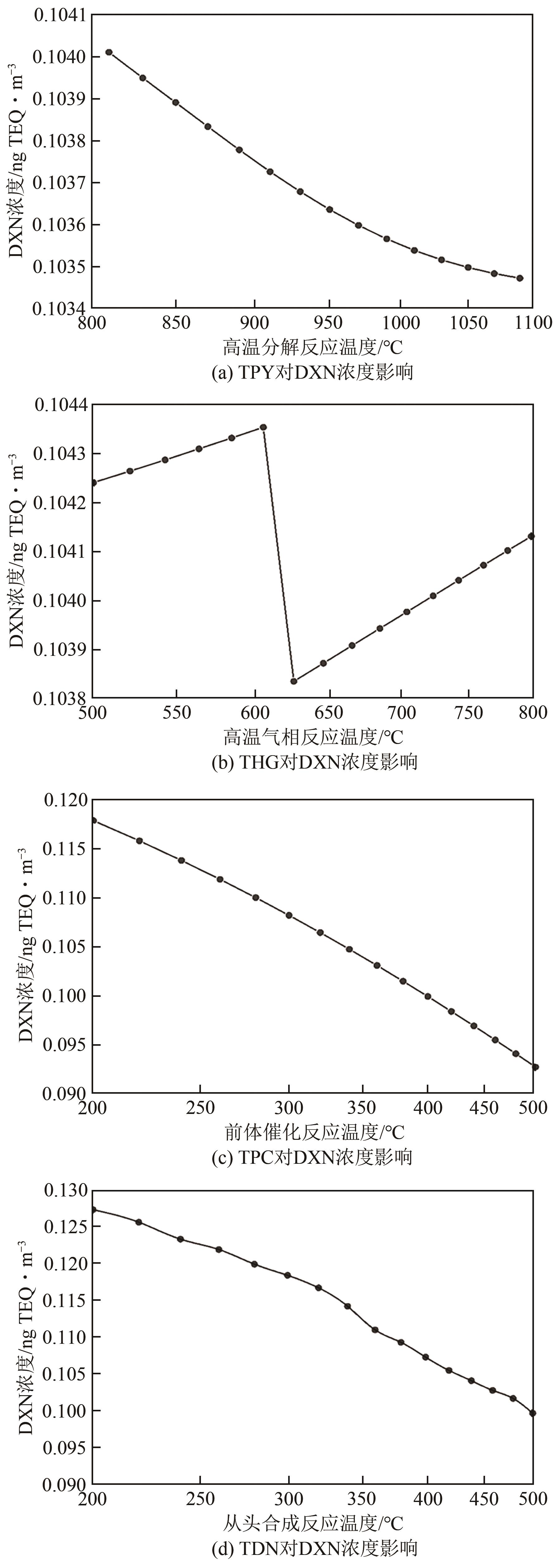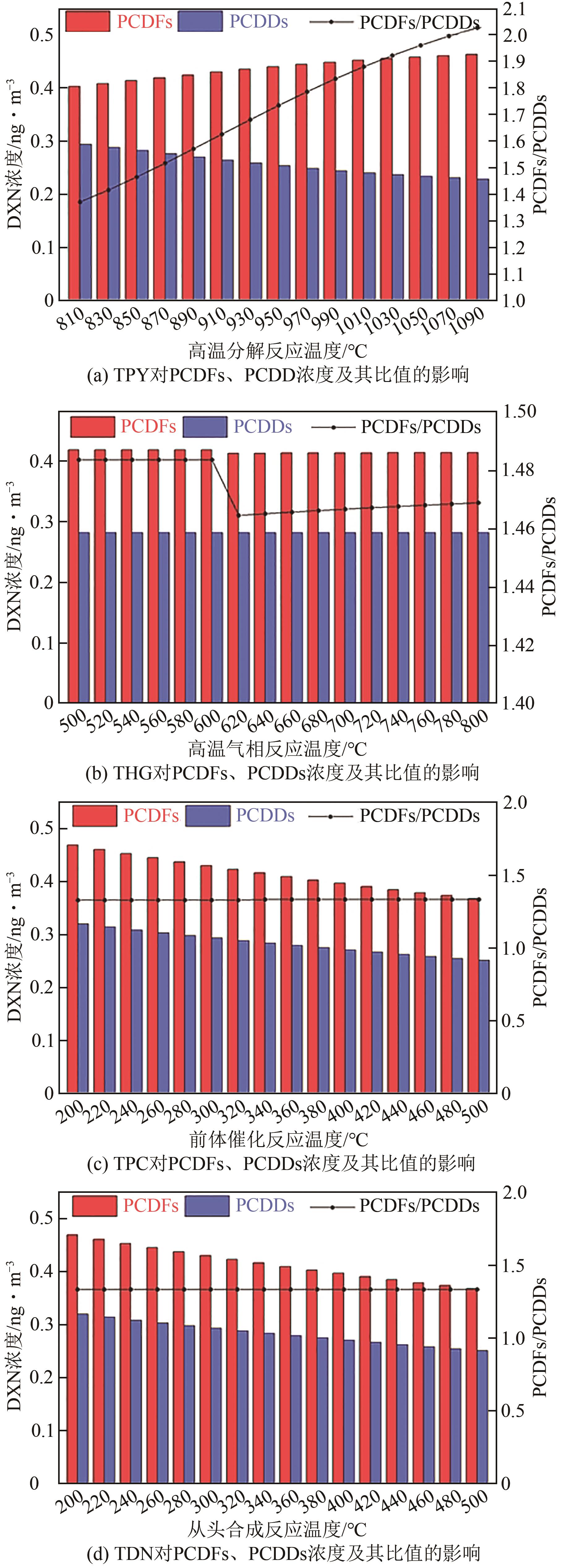化工进展 ›› 2023, Vol. 42 ›› Issue (2): 1061-1072.DOI: 10.16085/j.issn.1000-6613.2022-0738
城市固废炉排炉焚烧过程二𫫇英排放浓度数值仿真
陈佳昆1,2( ), 汤健1,2(
), 汤健1,2( ), 夏恒1,2, 乔俊飞1,2
), 夏恒1,2, 乔俊飞1,2
- 1.北京工业大学信息学部,北京 100124
2.智慧环保北京实验室,北京 100124
-
收稿日期:2022-04-24修回日期:2022-06-04出版日期:2023-02-25发布日期:2023-03-13 -
通讯作者:汤健 -
作者简介:陈佳昆(1998—),男,硕士研究生,研究方向为城市固废焚烧过程数值仿真与建模。E-mail:ChenJK@emails.bjut.edu.cn。 -
基金资助:北京市自然科学基金(4212032);国家自然科学基金(62073006)
Numerical simulation of dioxin emission concentration in grate furnace incineration processes for municipal solid waste
CHEN Jiakun1,2( ), TANG Jian1,2(
), TANG Jian1,2( ), XIA Heng1,2, QIAO Junfei1,2
), XIA Heng1,2, QIAO Junfei1,2
- 1.Faculty of Information Technology, Beijing University of Technology, Beijing 100124, China
2.Beijing Laboratory of Smart Environmental Protection, Beijing 100024, China
-
Received:2022-04-24Revised:2022-06-04Online:2023-02-25Published:2023-03-13 -
Contact:TANG Jian
摘要:
城市固废焚烧(MSWI)过程产生的二𫫇英(DXN)是至今机理仍复杂不清的剧毒污染物,获悉DXN在炉排炉内的生成、燃烧和再生成等过程的边界条件对降低污染排放极为重要。对此,本文提出了城市固废炉排炉焚烧过程DXN排放浓度数值仿真方法。首先,依据面向DXN的典型炉排炉MSWI工艺流程,描述焚烧炉内固相燃烧、气相燃烧、高温换热和低温换热等与DXN相关反应的机理。接着,依据上述所划分区域,结合实际MSWI过程相关参数构建DXN数值仿真模型。最后,基于烟气分流分率所表征的反应物浓度和不同区域的反应温度进行单因素分析,以获取G1处DXN浓度的边界条件,并基于正交实验分析分流分率和反应温度对G1处DXN浓度的影响,进而获得最优参数组合。基于北京某MSWI电厂实际数据的数值仿真分析与验证,表明了该数值仿真模型的有效性,为后续优化控制G1处的DXN排放浓度提供了支撑。
中图分类号:
引用本文
陈佳昆, 汤健, 夏恒, 乔俊飞. 城市固废炉排炉焚烧过程二𫫇英排放浓度数值仿真[J]. 化工进展, 2023, 42(2): 1061-1072.
CHEN Jiakun, TANG Jian, XIA Heng, QIAO Junfei. Numerical simulation of dioxin emission concentration in grate furnace incineration processes for municipal solid waste[J]. Chemical Industry and Engineering Progress, 2023, 42(2): 1061-1072.
| 模块类型 | 模块名称 | 模块作用 | 温度/℃ | 压强/kPa |
|---|---|---|---|---|
| RStoic | Dry | 降低MSW含水率 | 250 | 101.295 (微负压) |
| Deacon | Deacon反应 | 600 | ||
| RGibbs | CombustionA1-CombustionA10 CombustionB1-CombustionB10 CombustionC1-CombustionC10 CombustionD1-CombustionD10 | 固相燃烧,产生DXN | 500 | |
| 600 | ||||
| 700 | ||||
| 500 | ||||
| PY1-PY10 | 气相燃烧,DXN分解 | 850 | ||
| HG1-HG10 | 高温气相反应 | 650 | ||
| PC1-PC10 | 前体催化反应 | 350 | ||
| DN1-DN10 | 从头合成反应 | 350 | ||
| RYield | DryGrate BurnGrate1 BurnGrate2 BurnoutGrate | 将MSW转化为 可识别的 常规组分, 模拟挥发分析出 | 500 | |
| 600 | ||||
| 700 | ||||
| 500 | ||||
| Sep | Sep1-Sep10 | 组分分离 | — | — |
| Fsplit | Split1-Split21 | 分离流股 | — | — |
| Mixer | Mix1-Mix11 | 混合流股 | — | — |
表1 所采用模型模块的统计信息
| 模块类型 | 模块名称 | 模块作用 | 温度/℃ | 压强/kPa |
|---|---|---|---|---|
| RStoic | Dry | 降低MSW含水率 | 250 | 101.295 (微负压) |
| Deacon | Deacon反应 | 600 | ||
| RGibbs | CombustionA1-CombustionA10 CombustionB1-CombustionB10 CombustionC1-CombustionC10 CombustionD1-CombustionD10 | 固相燃烧,产生DXN | 500 | |
| 600 | ||||
| 700 | ||||
| 500 | ||||
| PY1-PY10 | 气相燃烧,DXN分解 | 850 | ||
| HG1-HG10 | 高温气相反应 | 650 | ||
| PC1-PC10 | 前体催化反应 | 350 | ||
| DN1-DN10 | 从头合成反应 | 350 | ||
| RYield | DryGrate BurnGrate1 BurnGrate2 BurnoutGrate | 将MSW转化为 可识别的 常规组分, 模拟挥发分析出 | 500 | |
| 600 | ||||
| 700 | ||||
| 500 | ||||
| Sep | Sep1-Sep10 | 组分分离 | — | — |
| Fsplit | Split1-Split21 | 分离流股 | — | — |
| Mixer | Mix1-Mix11 | 混合流股 | — | — |
| 工业分析 | 元素分析 | |||||||||
|---|---|---|---|---|---|---|---|---|---|---|
| 水分M(ar) | 固定碳FC(d) | 挥发分 V(d) | 灰分 ASH(d) | C(d) | H(d) | N(d) | Cl(d) | S(d) | O(d) | |
| 36.3 | 14.16 | 60.08 | 25.76 | 47.66 | 6.17 | 0.33 | 0.88 | 0.17 | 19.03 | |
表2 工业现场MSW的工业分析和元素分析单位:%
| 工业分析 | 元素分析 | |||||||||
|---|---|---|---|---|---|---|---|---|---|---|
| 水分M(ar) | 固定碳FC(d) | 挥发分 V(d) | 灰分 ASH(d) | C(d) | H(d) | N(d) | Cl(d) | S(d) | O(d) | |
| 36.3 | 14.16 | 60.08 | 25.76 | 47.66 | 6.17 | 0.33 | 0.88 | 0.17 | 19.03 | |
| 位置 | 温度/℃ | 流量/kg·h-1 | 组成(摩尔分率) |
|---|---|---|---|
| 一次风 | |||
| 干燥炉排 | 226.85 | 20688 | N2/O2=0.79/0.21 |
| 燃烧炉排1 | 226.85 | 43962 | |
| 燃烧炉排2 | 226.85 | 18102 | |
| 燃烬炉排 | 226.85 | 5172 | |
| 二次风 | |||
| 炉膛前拱和后拱 | 28.65 | 9051 |
表3 与工业现场相同的一次风和二次风设置
| 位置 | 温度/℃ | 流量/kg·h-1 | 组成(摩尔分率) |
|---|---|---|---|
| 一次风 | |||
| 干燥炉排 | 226.85 | 20688 | N2/O2=0.79/0.21 |
| 燃烧炉排1 | 226.85 | 43962 | |
| 燃烧炉排2 | 226.85 | 18102 | |
| 燃烬炉排 | 226.85 | 5172 | |
| 二次风 | |||
| 炉膛前拱和后拱 | 28.65 | 9051 |
| 来源模块-流股名称 | 分流分率 | 反应模块-温度名称 | 温度/℃ |
|---|---|---|---|
| Split9-SPY | 1×10-4 | Pyrolysis-TPY | 850 |
| Split15-SHG | 1×10-3 | Homogeneous-THG | 650 |
| Split17-SPC | 1×10-3 | PrecursorCatalytic-TPC | 350 |
| Split20-SDN | 1×10-7 | DeNovo-TDN | 350 |
表4 DXN相关模块的分流分率与反应温度设置
| 来源模块-流股名称 | 分流分率 | 反应模块-温度名称 | 温度/℃ |
|---|---|---|---|
| Split9-SPY | 1×10-4 | Pyrolysis-TPY | 850 |
| Split15-SHG | 1×10-3 | Homogeneous-THG | 650 |
| Split17-SPC | 1×10-3 | PrecursorCatalytic-TPC | 350 |
| Split20-SDN | 1×10-7 | DeNovo-TDN | 350 |
| 水平 | A | B | C | D | E/℃ | F/℃ | G/℃ | H/℃ |
|---|---|---|---|---|---|---|---|---|
| 1 | 5×10-5 | 5×10-4 | 5×10-4 | 5×10-8 | 800 | 500 | 200 | 200 |
| 2 | 1×10-4 | 1×10-3 | 1×10-3 | 1×10-7 | 850 | 650 | 350 | 350 |
| 3 | 1.5×10-4 | 1.5×10-3 | 1.5×10-3 | 1.5×10-7 | 900 | 800 | 500 | 500 |
表5 因素水平表
| 水平 | A | B | C | D | E/℃ | F/℃ | G/℃ | H/℃ |
|---|---|---|---|---|---|---|---|---|
| 1 | 5×10-5 | 5×10-4 | 5×10-4 | 5×10-8 | 800 | 500 | 200 | 200 |
| 2 | 1×10-4 | 1×10-3 | 1×10-3 | 1×10-7 | 850 | 650 | 350 | 350 |
| 3 | 1.5×10-4 | 1.5×10-3 | 1.5×10-3 | 1.5×10-7 | 900 | 800 | 500 | 500 |
| 案例 | A | B | C | D | E | F | G | H | DXN浓度/ng TEQ·m-3 | PCDFs浓度/ng·m-3 | PCDDs浓度/ng·m-3 | PCDFs/PCDDs |
|---|---|---|---|---|---|---|---|---|---|---|---|---|
| 1 | 1 | 1 | 1 | 1 | 1 | 1 | 1 | 1 | 0.0578 | 0.1759 | 0.1295 | 1.3579 |
| 2 | 1 | 1 | 1 | 1 | 2 | 2 | 2 | 2 | 0.0353 | 0.1343 | 0.0984 | 1.3650 |
| 3 | 1 | 1 | 1 | 1 | 3 | 3 | 3 | 3 | 0.0286 | 0.1087 | 0.0793 | 1.3700 |
| 25 | 3 | 3 | 2 | 1 | 1 | 3 | 2 | 3 | 0.1395 | 0.4210 | 0.4345 | 0.9688 |
| 26 | 3 | 3 | 2 | 1 | 2 | 1 | 3 | 1 | 0.1532 | 0.5059 | 0.4225 | 1.1974 |
| 27 | 3 | 3 | 2 | 1 | 3 | 2 | 1 | 2 | 0.1740 | 0.6211 | 0.4419 | 1.4055 |
表6 正交实验方案及结果
| 案例 | A | B | C | D | E | F | G | H | DXN浓度/ng TEQ·m-3 | PCDFs浓度/ng·m-3 | PCDDs浓度/ng·m-3 | PCDFs/PCDDs |
|---|---|---|---|---|---|---|---|---|---|---|---|---|
| 1 | 1 | 1 | 1 | 1 | 1 | 1 | 1 | 1 | 0.0578 | 0.1759 | 0.1295 | 1.3579 |
| 2 | 1 | 1 | 1 | 1 | 2 | 2 | 2 | 2 | 0.0353 | 0.1343 | 0.0984 | 1.3650 |
| 3 | 1 | 1 | 1 | 1 | 3 | 3 | 3 | 3 | 0.0286 | 0.1087 | 0.0793 | 1.3700 |
| 25 | 3 | 3 | 2 | 1 | 1 | 3 | 2 | 3 | 0.1395 | 0.4210 | 0.4345 | 0.9688 |
| 26 | 3 | 3 | 2 | 1 | 2 | 1 | 3 | 1 | 0.1532 | 0.5059 | 0.4225 | 1.1974 |
| 27 | 3 | 3 | 2 | 1 | 3 | 2 | 1 | 2 | 0.1740 | 0.6211 | 0.4419 | 1.4055 |
| 指标 | A | B | C | D | E | F | G | H |
|---|---|---|---|---|---|---|---|---|
| DXN浓度 | ||||||||
| 极差R | 0.0301 | 0.0632 | 0.0609 | 0.0502 | 0.0066 | 0.0028 | 0.0373 | 0.0323 |
| 主次顺序 | B>C>D>G>H>A>E>F | |||||||
| 最优水平 | A1 | B1 | C1 | D1 | E2 | F2 | G3 | H3 |
| PCDFs浓度 | ||||||||
| 极差R | 0.0896 | 0.1657 | 0.1423 | 0.1308 | 0.0301 | 0.0266 | 0.1415 | 0.124 |
| 主次顺序 | B>C>G>D>H>A>E>F | |||||||
| 最优水平 | A1 | B1 | C1 | D1 | E1 | F3 | G3 | H3 |
| PCDDs浓度 | ||||||||
| 极差R | 0.1573 | 0.1331 | 0.1254 | 0.1125 | 0.0348 | 0.0287 | 0.0709 | 0.08 |
| 主次顺序 | A>B>C>D>H>G>E>F | |||||||
| 最优水平 | A1 | B1 | C1 | D1 | E3 | F1 | G3 | H3 |
| PCDFs/PCDDs | ||||||||
| 极差R | 0.436 | 0.158 | 0.148 | 0.163 | 0.107 | 0.208 | 0.208 | 0.213 |
| 主次顺序 | A>H>G>F>D>B>C>E | |||||||
| 最优水平 | — | — | — | — | — | — | — | — |
表7 极差分析表
| 指标 | A | B | C | D | E | F | G | H |
|---|---|---|---|---|---|---|---|---|
| DXN浓度 | ||||||||
| 极差R | 0.0301 | 0.0632 | 0.0609 | 0.0502 | 0.0066 | 0.0028 | 0.0373 | 0.0323 |
| 主次顺序 | B>C>D>G>H>A>E>F | |||||||
| 最优水平 | A1 | B1 | C1 | D1 | E2 | F2 | G3 | H3 |
| PCDFs浓度 | ||||||||
| 极差R | 0.0896 | 0.1657 | 0.1423 | 0.1308 | 0.0301 | 0.0266 | 0.1415 | 0.124 |
| 主次顺序 | B>C>G>D>H>A>E>F | |||||||
| 最优水平 | A1 | B1 | C1 | D1 | E1 | F3 | G3 | H3 |
| PCDDs浓度 | ||||||||
| 极差R | 0.1573 | 0.1331 | 0.1254 | 0.1125 | 0.0348 | 0.0287 | 0.0709 | 0.08 |
| 主次顺序 | A>B>C>D>H>G>E>F | |||||||
| 最优水平 | A1 | B1 | C1 | D1 | E3 | F1 | G3 | H3 |
| PCDFs/PCDDs | ||||||||
| 极差R | 0.436 | 0.158 | 0.148 | 0.163 | 0.107 | 0.208 | 0.208 | 0.213 |
| 主次顺序 | A>H>G>F>D>B>C>E | |||||||
| 最优水平 | — | — | — | — | — | — | — | — |
| 1 | 乔俊飞, 郭子豪, 汤健. 面向城市固废焚烧过程的DXN排放浓度检测方法综述[J]. 自动化学报, 2020, 46(6): 1063-1089. |
| QIAO Junfei, GUO Zihao, TANG Jian. Dioxin emission concentration measurement approaches for municipal solid wastes incineration process: A survey[J]. Acta Automatica Sinica, 2020, 46(6): 1063-1089. | |
| 2 | 陈安, 陈晶睿, 崔晶, 等. 中国31个直辖市和省会(首府)城市“垃圾围城”风险与对策研究——基于DIIS方法的实证研究[J]. 中国科学院院刊, 2019, 34(7): 797-806. |
| CHEN An, CHEN Jingrui, CUI Jing, et al. Research on risks and countermeasures of “cities besieged by waste” in China——an empirical analysis based on DIIS[J]. Bulletin of Chinese Academy of Sciences, 2019, 34(7): 797-806. | |
| 3 | ARAFAT Hassan A, JIJAKLI Kenan, AHSAN Amimul. Environmental performance and energy recovery potential of five processes for municipal solid waste treatment[J]. Journal of Cleaner Production, 2015, 105: 233-240. |
| 4 | 汤健, 夏恒, 乔俊飞, 等. 深度集成森林回归建模方法及应用[J]. 北京工业大学学报, 2021, 47(11): 1219-1229. |
| TANG Jian, XIA Heng, QIAO Junfei, et al. Modeling method of deep ensemble forest regression with its application[J]. Journal of Beijing University of Technology, 2021, 47(11): 1219-1229. | |
| 5 | 汤健, 王丹丹, 郭子豪 等. 基于虚拟样本优化选择的城市固废焚烧过程二𫫇英排放浓度预测[J]. 北京工业大学学报, 2021, 47(5): 431-443. |
| TANG Jian, WANG Dandan, GUO Zihao, et al. Prediction of dioxin emission concentration in the municipal solid waste incineration process based on optimal selection of virtual samples[J]. Journal of Beijing University of Technology, 2021, 47(5): 431-443. | |
| 6 | BALLSCHMITER K, SWEREV M. Reaction pathways for the formation of polychlorodibenzodioxins (PCDD) and-furans (PCDF) in combustion processes I[J]. Fresenius' Zeitschrift Für Analytische Chemie, 1987, 328(1/2): 125-127. |
| 7 | WEBER Roland, HAGENMAIER Hanspaul. Mechanism of the formation of polychlorinated dibenzo-p-dioxins and dibenzofurans from chlorophenols in gas phase reactions[J]. Chemosphere, 1999, 38(3): 529-549. |
| 8 | KHACHATRYAN Lavrent, ASATRYAN Ruben, DELLINGER Barry. An elementary reaction kinetic model of the gas-phase formation of polychlorinated dibenzofurans from chlorinated phenols[J]. The Journal of Physical Chemistry A, 2004, 108(44): 9567-9572. |
| 9 | ALTARAWNEH M, DLUGOGORSKI B Z, KENNEDY E M, et al. Mechanisms for formation, chlorination, dechlorination and destruction of polychlorinated dibenzo-p-dioxins and dibenzofurans (PCDD/Fs)[J]. Progress in Energy and Combustion Science, 2009, 35(3): 245-274. |
| 10 | LOMNICKI Slawomir, DELLINGER Barry. A detailed mechanism of the surface-mediated formation of PCDD/F from the oxidation of 2-chlorophenol on a CuO/silica surface[J]. The Journal of Physical Chemistry A, 2003, 107(22): 4387-4395. |
| 11 | NGANAI S, LOMNICKI S M, DELLINGER B. Formation of PCDD/Fs from the copper oxide-mediated pyrolysis and oxidation of 1,2-dichlorobenzene[J]. Environmental Science & Technology, 2011, 45(3): 1034-1040. |
| 12 | STIEGLITZ L, VOGG H. On formation conditions of PCDD/PCDF in fly ash from municipal waste incinerators[J]. Chemosphere, 1987, 16(8/9): 1917-1922. |
| 13 | ZHANG Mengmei, BUEKENS Alfons. De novo synthesis of dioxins: A review[J]. International Journal of Environment and Pollution, 2016, 60(1/2/3/4): 63-110. |
| 14 | EBOH Francis Chinweuba, ANDERSSON Bengt-Åke, RICHARDS Tobias. Economic evaluation of improvements in a waste-to-energy combined heat and power plant[J]. Waste Management, 2019, 100: 75-83. |
| 15 | 李树森. 城市固体生活垃圾O2/CO2燃烧发电厂流程仿真模拟与优化[D]. 北京: 北京交通大学, 2015. |
| LI Shusen. Process simulation and optimization of the municipal solid waste fired power plant with O2/CO2 combustion[D]. Beijing: Beijing Jiaotong University, 2015. | |
| 16 | HUAI X L, XU W L, QU Z Y, et al. Numerical simulation of municipal solid waste combustion in a novel two-stage reciprocating incinerator[J]. Waste Management, 2008, 28(1): 15-29. |
| 17 | ZHUANG J, TANG J, QIAO J. Numerical simulation of municipal solid waste incineration process based on chemical process simulation software[C]. Shanghai: Proceedings of the 2021 40th Chinese Control Conference (CCC), 2021. |
| 18 | SUN R, ISMAIL T M, REN X, et al. Numerical simulation of gas concentration and dioxin formation for MSW combustion in a fixed bed[J]. Journal of Environmental Management, 2015, 157: 111-117. |
| 19 | 应雨轩, 林晓青, 吴昂键, 等. 生活垃圾智慧焚烧的研究现状及展望[J]. 化工学报, 2021, 72(2): 886-900. |
| YING Yuxuan, LIN Xiaoqing, WU Angjian, et al. Review and outlook on municipal solid waste smart incineration[J]. CIESC Journal, 2021, 72(2): 886-900. | |
| 20 | WEI J, LI H, LIU J. Fate of dioxins in a municipal solid waste incinerator with state-of-the-art air pollution control devices in China[J]. Environmental Pollution, 2021, 289: 117798. |
| 21 | DENG Dongyang, QIAO Junqin, LIU Mingqing, et al. Detoxification of municipal solid waste incinerator (MSWI) fly ash by single-mode microwave (MW) irradiation: Addition of urea on the degradation of Dioxin and mechanism[J]. Journal of Hazardous Materials, 2019, 369: 279-289. |
| 22 | STANMORE B R. The formation of dioxins in combustion systems[J]. Combustion and Flame, 2004, 136(3): 398-427. |
| 23 | ZHANG Sheng, CHEN Zhiliang, LIN Xiaoqing, et al. Kinetics and fusion characteristics of municipal solid waste incineration fly ash during thermal treatment[J]. Fuel, 2020, 279: 118410. |
| 24 | ZHONG Rigang, CAI Jianjun, YAN Feng, et al. Process tracing and partitioning behaviors of PCDD/Fs in the post-combustion zone from a full-scale municipal solid waste incinerator in Southern China[J]. Environmental Technology & Innovation, 2021, 23: 101789. |
| 25 | PENG Yaqi, CHEN Jinghao, LU Shengyong, et al. Chlorophenols in municipal solid waste incineration: A review[J]. Chemical Engineering Journal, 2016, 292: 398-414. |
| 26 | TUNGALAG Azjargal, LEE Bongju, YADAV Manoj, et al. Yield prediction of MSW gasification including minor species through ASPEN plus simulation [J]. Energy, 2020, 198: 117296. |
| 27 | LUIJK R, AKKERMAN D M, SLOT P, et al. Mechanism of formation of polychlorinated dibenzo-p-dioxins and dibenzofurans in the catalyzed combustion of carbon[J]. Environmental Science & Technology, 1994, 28(2): 312-321. |
| 28 | 邱坤赞, 严建华, 岑可法, 等. 二𫫇英在流化床垃圾焚烧炉内生成及分解的模拟计算[J]. 电站系统工程, 2003, 19(3): 15-16, 18. |
| QIU Kunzan, YAN Jianhua, CEN Kefa, et al. Simulated calculation on formation and decomposition of dioxin in FB incinerator[J]. Power System Engineering, 2003, 19(3): 15-16, 18. | |
| 29 | HELL K, STIEGLITZ L, ALTWICKER E R, et al. Reactions of 2,4,6-trichlorophenol on model fly ash: Oxidation to CO and CO2, condensation to PCDD/F and conversion into related compounds[J]. Chemosphere, 2001, 42(5/6/7): 697-702. |
| 30 | Evalena WIKSTRÖM, RYAN Shawn, TOUATI Abderrahmane, et al. Key parameters for de novo formation of polychlorinated dibenzo-p-dioxins and dibenzofurans[J]. Environmental Science & Technology, 2003, 37(9): 1962-1970. |
| 31 | SHAUB W M, TSANG W. Dioxin formation in incinerators[J]. Environmental Science & Technology, 1983, 17(12): 721-730. |
| [1] | 孙继鹏, 韩靖, 唐杨超, 闫汉博, 张杰瑶, 肖苹, 吴峰. 硫黄湿法成型过程数值模拟与操作参数优化[J]. 化工进展, 2023, 42(S1): 189-196. |
| [2] | 郑瑾, 韩瑞瑞, 李丹丹, 王馨妤, 高春阳, 杜显元, 张晓飞, 邹德勋. 过氧化尿素与微生物联合修复石油污染土壤[J]. 化工进展, 2022, 41(9): 5085-5093. |
| [3] | 丁兴江, 章学来, 朱嘉豪, 毛发, 房满庭, 冯天平. 三水合乙酸钠复合相变材料过冷特性实验统计分析[J]. 化工进展, 2022, 41(11): 5946-5960. |
| [4] | 刘少斌, 齐宏, 余智强, 何明键, 于喜奎. 基于Taguchi方法的微小通道性能分析与参数优化[J]. 化工进展, 2021, 40(12): 6409-6422. |
| [5] | 李丽, 刘宝树, 郑学明, 孙华. 舒巴坦钠溶析结晶工艺优化[J]. 化工进展, 2019, 38(06): 2905-2914. |
| [6] | 王治红, 丁晓明, 吴明鸥, 沈晓燕. 有机朗肯循环在多品位余热发电中的应用[J]. 化工进展, 2019, 38(05): 2189-2196. |
| [7] | 郭睿, 宋博, 郭煜, 李云鹏, 土瑞香, 王映月, 马兰. 木质素磺酸盐接枝共聚物的合成及工艺优化[J]. 化工进展, 2018, 37(05): 1962-1967. |
| [8] | 刘忠慧, 于旷世, 张海霞, 朱治平. 基于Aspen Plus的循环流化床工业气化炉模拟[J]. 化工进展, 2018, 37(05): 1709-1717. |
| [9] | 程琛, 闫正. 复频超声降解土霉素废水[J]. 化工进展, 2015, 34(04): 1143-1146,1164. |
| [10] | 刘军霞, 姚庆鑫, 杨金, 周磊, 谢建军. 多指标正交实验优化可发性三聚氰胺甲醛树脂的制备[J]. 化工进展, 2015, 34(02): 474-478. |
| [11] | 古蒙蒙1,涂文辉1,桂绍庸1,蔡卫权1,林元虹1,李玉军1,曹宏2?. 环保型高效稠油垢弱酸性水基清洗剂的研制[J]. 化工进展, 2014, 33(06): 1563-1566. |
| [12] | 冉二艳,张宝昌,周如彬,赵莹,刘扬. 氨基聚醚共改性硅油的合成与性能[J]. 化工进展, 2014, 33(02): 445-452. |
| [13] | 蔡光义,马名杰,熊耀,张超,郭卫杰. [J]. 化工进展, 2014, 33(01): 70-74. |
| [14] | 高学艺,武彦伟,王克冰. 沙柳酸催化水解制备乙酰丙酸及分离提纯[J]. 化工进展, 2014, 33(01): 242-246. |
| [15] | 李玉军1,蔡卫权1,宋素娟1,王 文1,曹 宏2. 高效油烟机重油垢环保型水基清洗剂的研制[J]. 化工进展, 2013, 32(08): 1898-1901. |
| 阅读次数 | ||||||
|
全文 |
|
|||||
|
摘要 |
|
|||||

